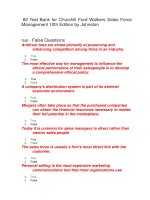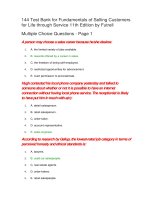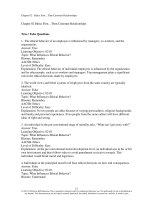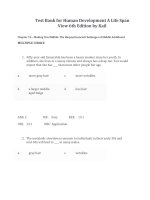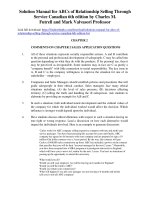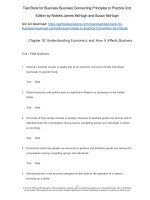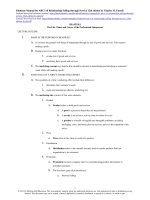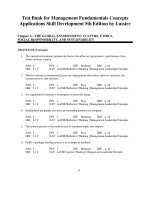143 test bank for ABCs of relationship selling through service 11th edition by futrell đề trắc nghiệm marketing
Bạn đang xem bản rút gọn của tài liệu. Xem và tải ngay bản đầy đủ của tài liệu tại đây (155.76 KB, 27 trang )
143 Test Bank for ABCs of Relationship Selling
through Service 11th Edition by Futrell
True - False Questions
Selling is both an art and a science.
1.
2.
True
False
Relationship selling is the creation of customer loyalty.
1.
2.
True
False
The sales process refers to the checklist salespeople use to
prepare themselves for dealing with prospects'
objections.
1.
2.
True
False
Patience is the most difficult trait for a salesperson to
develop.
1.
2.
True
False
Self-control refers to the discipline needed to rise early, work
early, and prepare for the next day in the evening.
1.
2.
True
False
Selling and marketing are not synonymous.
1.
2.
True
False
One of the reasons to choose a sales career is the wide
variety of sales jobs available.
1.
2.
True
False
To be a successful salesperson, a salesperson must love to
sell.
1.
True
2.
False
As a profession, salespeople need no more tact than those
in any other profession.
1.
2.
True
False
Conceptual skills are especially important for the creative
order-takers.
1.
2.
True
False
It is inappropriate for a salesperson to provide information to
his/her company on such topics as competitors'
activities and market opportunities since doing so
would exceed his/her authority and violate customer
confidence.
1.
2.
True
False
A salesperson needs physical, spiritual, and mental stamina
to succeed.
1.
2.
True
False
The marketing concept is a business philosophy that says
the customers' want, satisfaction is the economic and
social justification for a firm's existence.
1.
2.
True
False
If you fail to realize success, your own prejudices can be the
cause by throwing an invisible barrier across your
path.
1.
2.
True
False
Today's salesperson needs personal characteristics that
allow for true caring for customers.
1.
2.
True
False
A sales engineer works for a manufacturer and sells the
benefits of intangible products.
1.
2.
True
False
Conceptual skill is the seller's ability to work with and
through other people.
1.
2.
True
False
The last step in the sales process is the close.
1.
2.
True
False
Technical skill is the cognitive ability to see the selling
process as a whole and the relationship among its
parts.
1.
2.
True
False
Given that sales jobs offer higher nonfinancial rewards than
most other areas of corporate America, the
compensation of salespeople is typically lower than
that of workers in areas like production and personnel
who are at a comparable level in the organization.
1.
2.
True
False
Financial rewards for professional salespeople are
commonly solely based on performance.
1.
2.
True
False
There are no differences between what a service salesperson
sells and what an industrial products salesperson
sells.
1.
2.
True
False
Many selling skills cannot be learned from a textbook, but
must be developed through practice, just like tennis.
1.
True
2.
False
Personal selling is personal communication of information to
unselfishly persuade a prospective customer to buy an
idea that satisfies his or her needs.
1.
2.
True
False
E-selling is limited to sales made through the use of Web
sites.
1.
2.
True
False
While salespeople typically provide many services for their
customers, returning damaged merchandise is not one
of them.
1.
2.
True
False
As manager of a sales territory, a salesperson is responsible
for providing solutions to customers' problems.
1.
2.
True
False
Creative selling is an important part of what an order-taker
does.
1.
2.
True
False
A telemarketer is an example of a direct seller.
1.
2.
True
False
A salesperson's career path is the upward sequence of job
movements during a sales career.
1.
2.
True
False
Even experienced sales representatives in outside sales
typically receive intensive direct supervision.
1.
2.
True
False
The Small Business Administration classifies approximately
50 percent of all business in the United States as small
businesses.
1.
2.
True
False
The Golden Rule of Personal Selling describes the
willingness to plan and execute product, price,
distribution, and promotion plans so as to create
exchanges that satisfy individual and organizational
objectives.
1.
2.
True
False
The acronym ABCS represents the tools needed for creating
a successful marketing mix.
1.
2.
True
False
People tend to form generalizations that most salespeople
are not ethical.
1.
2.
True
False
Today's salespeople make a contribution to the welfare of
others through service.
1.
2.
True
False
A wholesale salesperson would sell designer clothing to a
department store which in turn would resell the items
to individual customers.
1.
2.
True
False
Salespeople need not increase sales in old accounts if they
are generating a sufficient number of new customers.
1.
2.
True
False
Multiple Choice Questions - Page 1
Which element of the marketing mix is being discussed
when the salesperson participates in a trade show?
1.
2.
3.
4.
5.
A. Pricing
B. Distribution
C. Direct sales
D. Product
E. Promotion
A newer definition of _____ defines it as the personal
communication of information to unselfishly persuade
a prospective customer to buy something that satisfies
that individual's needs.
1.
2.
3.
4.
5.
A. integrated marketing communications
B. dyadic communications
C. personal selling
D. transactional marketing
E. relationship marketing
According to Gallup, which of the following was rated the
lowest-rated job category based on perceived honesty
and ethical standards from 1977 to 2001?
1.
2.
3.
4.
5.
A. Used car salespeople
B. Insurance salespeople
C. Advertising practitioners
D. Mortgage brokers
E. Financial advisers
The _____ is a business philosophy that says the customers'
want-satisfaction is the economic and social
justification for a firm's existence.
1.
2.
3.
4.
5.
A. Six Sigma concept
B. TQM concept
C. scientific approach to business
D. marketing concept
E. sales heuristic
Which of the following falls within the definition of "place"?
1.
2.
3.
4.
5.
A. Promotional allowances
B. Returns
C. Image
D. Inventory
E. Customer service
_____ is defined as the personal communication of
information to persuade a prospective customer to buy
something that satisfies his/her needs.
1.
2.
3.
4.
5.
A. Marketing
B. Personal selling
C. Promotion
D. Public relations
E. Advertising
The person behind the counter at the movie theater who
asks you what movie you wish to see, takes your
money and hands you your ticket, would be classed as
a(n):
1.
2.
3.
4.
5.
A. retail salesperson.
B. sales engineer.
C. order-getter.
D. service salesperson.
E. account representative.
According to the _____, salespeople should unselfishly treat
others as they would like to be treated.
1.
2.
3.
4.
5.
A. Pareto Principle of Selling
B. Principle of Reciprocity
C. Fairplay Rule of Selling
D. Golden Rule of Personal Selling
E. Equity Theory of Selling
Promotional allowances are an element of this marketing
mix.
1.
2.
3.
4.
5.
A. Product
B. Place
C. Promotion
D. Distribution
E. Price
According to the text, a new and more appropriate definition
of personal selling:
1.
2.
3.
4.
5.
A. relates it more closely to transactional marketing.
B. excludes e-selling.
C. includes the word "unselfishly."
D. excludes telemarketing activities.
E. substitutes the word "relationship marketing" for "personal selling."
Another name for a salesperson is a(n):
1.
2.
3.
4.
5.
A. transaction manager.
B. exchange coordinator.
C. counter trader.
D. stakeholder supervisor.
E. customer contact person.
Sales jobs are classified according to the type of product
sold and:
1.
2.
3.
4.
5.
A. how the salesperson is compensated.
B. the type of customers the salesperson calls on.
C. jobs performed by the salesperson.
D. the salesperson's type of employer.
E. territory size.
Identify the correct statement about the importance of
salespeople and selling.
1.
2.
3.
4.
5.
A. Salespeople are responsible for the success of new products, but have little to
do with keeping existing products in the marketplace.
B. Salespeople are responsible for keeping existing products in the marketplace,
but have little to do with the success of new products.
C. Only the medical profession generates more revenue in our economy than the
selling profession.
D. Salespeople have a direct impact on the opening of new businesses and
whether that business is successful.
E. Only the legal profession generates more revenue in our economy than the
selling profession.
The person who phoned Howard last night to ask him if he
might be interested in adding HBO and Cinemax to his
current television cable system would be classified as
a(n):
1.
2.
3.
4.
5.
A. detail salesperson.
B. retail salesperson.
C. order-taker.
D. account representative.
E. sales engineer.
A salesperson who adheres to the Golden Rule of Personal
Selling:
1.
2.
3.
4.
5.
A. is primarily motivated by money.
B. is ego-driven.
C. does what he/she is legally required to do.
D. enjoys personal recognition.
E. attributes his/her success to others.
According to the Golden Rule of Personal Selling, an
effective salesperson:
1.
2.
3.
4.
5.
A. has the Midas touch.
B. owes greater allegiance to his/her employer than to customers.
C. unselfishly treats others as they would like to be treated.
D. can use manipulation if needed to make the sale.
E. creates customer loyalty through discipline, persistence and optimism.
Which of the following terms describes a bundle of tangible
and intangible attributes, including packaging, color,
brand and even the reputation of the seller?
1.
2.
3.
4.
5.
A. Price
B. Good
C. Product
D. Service
E. Distribution
A person may choose a sales career because he/she
desires:
1.
2.
3.
4.
5.
A. a job that is unchanging and requires mastery of a minimal number of skills.
B. the rewards offered by a career in sales.
C. the freedom of being self-employed.
D. the limited hours of work.
E. the minimal challenges it offers.
Joseph is a salesperson for a wholesale meat company. It
would NOT be part of his job to sell meat to:
1.
2.
3.
4.
5.
A. a final consumer.
B. the United States government.
C. a restaurant like McDonald's.
D. an assisted-living facility that is hosting a family cookout.
E. a hospital cafeteria.
Nancy Henderson is a saleswoman for a manufacturer of
small kitchen appliances. She does not directly solicit
orders. Her primary duties involve promotional
activities and introducing new products to her
employer's indirect customers. She spends much of
her time demonstrating appliances at various retail
stores. Nancy would be classified as a(n):
1.
2.
3.
A. retail salesperson.
B. detail salesperson.
C. sales engineer.
4.
5.
D. service salesperson.
E. account representative.
Personal selling:
1.
2.
A. refers only to sales made to individuals, not those made to businesses.
B. is defined as the mass communication of information to persuade a prospective
customer to buy something which satisfies that individual's needs.
3. C. describes the process during which someone is persuaded to buy something
which they may not want or need.
4. D. is defined as the personal communication of information to persuade a
prospective customer to buy something which satisfies that individual's needs.
5. E. is defined as sales made only to individuals in ways that benefit the
organization and its stakeholders.
All of the following fall under the term "product" in the
marketing mix EXCEPT:
1.
2.
3.
4.
5.
A. brand name.
B. services.
C. inventory.
D. returns.
E. image.
According to the text, the traditional definition of personal
selling includes all of the following EXCEPT:
1.
2.
3.
4.
5.
A. providing customers with information.
B. communication between buyer and seller.
C. providing after-the-sale service.
D. persuading a prospective customer to buy.
E. explaining the best-selling philosophy of the 21st century.
In which of the following situations is the individual not
actively engaged in selling?
1.
2.
3.
A. Steve is trying to convince his professor that he deserves an "A."
B. Brendan is persuading Meryl to loan him $10 so he can order a pizza.
C. Chad is trying to convince his biology lab partner to sketch the internal organs
of the frog they dissected in lab.
4. D. Anna is trying to persuade her husband to attend her family reunion.
5. E. Daniel is creating a logo for his home-based Web services company.
Which of the following statements about selling is true?
1.
2.
3.
4.
5.
A. You are not involved in sales when you go to an interview with a potential
employer.
B. Unlike other professions, journalists do not engage in selling activities.
C. Everyone sells at their place of work, but not when at home with their families.
D. You are involved in selling when you ask someone to accompany you on a
shopping trip.
E. Only trained salespeople ever engage in selling activities.
Selling occurs in all of the following instances EXCEPT:
1.
2.
3.
4.
5.
A. when you go to an interview with a potential employer.
B. when lawyers try to convince clients to sue.
C. when you ask someone to accompany you on a shopping trip.
D. when a journalist is trying to get an interview with Mel Gibson.
E. when a doctor directs a patient to take a particular medicine.
Which of the following statements about products, goods,
and services is true?
1.
2.
3.
4.
5.
A. Products and goods are synonymous terms
B. Services and products are tangibles
C. Goods and products are tangibles
D. Salespeople do not sell services
E. Goods and services are tangibles
Donna Carter goes from house-to-house in her
neighborhood taking orders for Pampered Chef
kitchen products. These sales that she makes face-toface to consumers who will use the products
themselves are examples of:
1.
2.
3.
4.
5.
A. retail selling.
B. wholesale selling.
C. account representation.
D. detail selling.
E. sales engineering.
Which of the following falls in the category, "place" in the
marketing mix?
1.
2.
3.
4.
5.
A. Wholesalers
B. Brand name
C. Promotional allowances
D. Trade shows
E. Features
89 Free Test Bank for ABCs of Relationship Selling
through Service 11th Edition by Futrell Multiple
Choice Questions - Page 2
The acronym ssuccess is used in selling to help you
remember the eight:
1.
2.
3.
A. most frequently listed skills needed to be successful in sales.
B. steps required to create a customer profile.
C. mental stages through which customers pass as they decide to sell.
4.
5.
D. types of knowledge a salesperson needs to succeed.
E. steps to creating the sales presentation.
A salesperson who follows the Golden Rule is a(n) _____
individual whom the customer can trust.
1.
2.
3.
4.
5.
A. morally ethical
B. profiteering
C. customer-oriented
D. experienced
E. arbitrary
Ted has been delivering "Creamy White" milk bottles to
houses in Austin town for the past 10 years. Identify
the type of manufacturer's sales representative Ted
represents.
1.
2.
3.
4.
5.
A. Detail salesperson
B. Sales engineer
C. Account representative
D. Industrial products salesperson
E. Service salesperson
In large firms like Xerox, 3M, and General Electric, a
salesperson's career path usually begins at the level
of:
1.
2.
3.
4.
5.
A. salesperson.
B. sales representative.
C. key account salesperson.
D. sales trainee.
E. assistant sales representative.
In which of the following industries are you most likely to
find a sales engineer?
1.
2.
3.
4.
5.
A. Apparel
B. Heavy equipment
C. Small appliances
D. Pet supplies
E. Envelopes
All of the following relate to the nonfinancial rewards that
you as a salesperson receive EXCEPT:
1.
2.
3.
4.
A. knowing your job.
B. intrinsic rewards.
C. customer entertainment allowances.
D. a feeling of self-worth.
5.
E. a reward generated by you, not given by the company.
_____ rewards are generated by the individual, not given by
the company.
1.
2.
3.
4.
5.
A. Financial
B. Extrinsic
C. Quantitative
D. Psychological
E. Physiological
The most difficult selling situation faced by a creative
salesperson is:
1.
2.
3.
4.
5.
A. persuading prospects that the current products they are using are no longer
satisfactory.
B. having to sell to numerous people in an organization to get one order.
C. handling questions and objections raised by prospects.
D. persuading people that they can afford something they think they cannot.
E. dealing with prospects who resent the salesperson coming to see them.
Alane sells drawer pulls, hinges, and other decorative metal
pieces used in the manufacture of furniture. Since the
products she sells to the furniture makers are
nontechnical in nature, Alane would be described as
a(n):
1.
2.
3.
4.
5.
A. account representative.
B. detail salesperson.
C. sales engineer.
D. order-taker.
E. industrial products salesperson.
Usually, the first sales management position to which a
salesperson is promoted is:
1.
2.
3.
4.
5.
A. senior salesperson.
B. district sales manager.
C. key accounts sales manager.
D. regional sales manager.
E. divisional sales manager.
Which of the following statements about order-getters is
true?
1.
2.
3.
4.
5.
A. They do not use a sales strategy
B. They never truly create sales
C. They avoid creative sales presentations
D. They often do not attempt to close a sale
E. They are useful for selling intangible services in highly competitive industries
A career in sales management begins with the position of:
1.
2.
3.
4.
5.
A. sales trainee.
B. salesperson.
C. sales representative.
D. key account salesperson.
E. assistant sales representative.
Which of the following is NOT an example of a financial
reward that a salesperson could receive?
1.
2.
3.
4.
5.
A. Travel expenses
B. Salary
C. Psychological income
D. Entertainment allowance
E. Company car
Order-takers:
1.
2.
3.
4.
5.
A. use creative sales strategies.
B. have an infinitely more difficult selling situation than order-getters.
C. usually earn much more than order-getters.
D. rely on well-executed sales presentations.
E. do not have a sales strategy and often do not use sales presentations.
_____ is the most important characteristic needed to be a
successful salesperson.
1.
2.
3.
4.
5.
A. Caring attitude
B. Believing that your customer is always right
C. Patience
D. Persistence
E. The ability to accept rejection
Which is the most difficult trait for a salesperson to
develop?
1.
2.
3.
4.
5.
A. Kindness
B. Self-control
C. Patience
D. Caring attitude
E. Fairness
Order-getters:
1.
2.
3.
4.
5.
A. do not use a sales strategy.
B. never truly create sales.
C. rely on creative sales presentations.
D. often do not attempt to close a sale.
E. are useful for selling tangible goods in highly competitive industries.
James sells blank aluminum cans for soda manufacturers to
fill and label. James would be classified as a(n):
1.
2.
3.
4.
5.
A. detail salesperson.
B. account representative.
C. sales engineer.
D. direct salesperson.
E. industrial products salesperson.
Salespeople who are order-_____ obtain new and repeat
business using creative sales strategies and wellexecuted sales presentations.
1.
2.
3.
4.
5.
A. collectors
B. takers
C. capturers
D. detailers
E. getters
Relationship selling:
1.
2.
3.
4.
5.
A. creates social responsibility.
B. eliminates cognitive dissonance.
C. is another term for reciprocal selling arrangements.
D. creates customer loyalty.
E. only occurs with transaction selling.
Which of the following is NOT a type of salesperson that you
would typically find selling for a manufacturer?
1.
2.
3.
4.
5.
A. Account representative
B. Detail salesperson
C. Sales engineer
D. Order-taker
E. Industrial products salesperson
In addition to performance, the salary earned by a sales
manager is usually related to all of the following
EXCEPT:
1.
2.
3.
4.
5.
A. the annual sales volume of units managed.
B. the number of salespeople managed.
C. the length of experience in sales.
D. the annual sales volume of the firm.
E. the educational qualifications.
According to the text, there are several questions you should
ask yourself as you decide whether a career in sales is
appropriate for you. Identify the question that you
need NOT think about before beginning a career in
sales.
1.
2.
3.
4.
5.
A. How much freedom do I want in a job?
B. Were my college grades high enough?
C. How much traveling am I willing to do?
D. Am I willing to transfer to another state?
E. What are my future goals?
Susan is a door-to-door insurance policy salesperson. She is
a(n):
1.
2.
3.
4.
5.
A. detail salesperson.
B. sales engineer.
C. account representative.
D. industrial products salesperson.
E. service salesperson.
Brian Simpson has recently joined "T Co." as a salesperson.
The company manufactures Xerox machines with five
unique features. Brian can be classified as a(n):
1.
2.
3.
4.
5.
A. detail salesperson.
B. sales engineer.
C. account representative.
D. industrial products salesperson.
E. service salesperson.
When Adrian sold a computer network to a Fortune 500
company, he often called on the company's
purchasing department to see if employees were
satisfied with the network and to see if the company
had any need for an upgrade or additional software.
This is an example of:
1.
2.
3.
4.
5.
A. transformational selling.
B. customer maintenance.
C. relationship selling.
D. transaction selling.
E. proactive marketing.
According to the text, there are several questions you should
ask yourself as you decide whether a career in sales is
appropriate for you. Which one of the following is NOT
one of the questions that you should ask before
beginning a career in sales?
1.
2.
3.
4.
5.
A. How much freedom do I want in a job?
B. Do I have the personality characteristics for the job?
C. Am I willing to transfer to another city?
D. What are my past accomplishments?
E. How much money do I want to earn?
Which of the following statements about sales success is
true?
1.
2.
A. For success in sales, it is more important to speak well than to listen well.
B. Of the eight work characteristics for sales success, love of selling is the most
important.
3. C. A successful salesperson does not need to think strategically because that is
the job of the sales manager.
4. D. Successful salespeople often can avoid providing service to customers if they
present a "nice guy" image.
5. E. Stamina is not necessary for sales success.
Insurance, gym memberships, and cruise vacations would
be sold by:
1.
2.
3.
4.
5.
A. detail salespeople.
B. account representatives.
C. sales engineers.
D. service salespeople.
E. industrial products salespeople.
Frey is a(n) _____ for a satellite television provider. If you
want to change your satellite television provider to the
one Frey sells for, you can call him on the telephone
and he will sell you the service.
1.
2.
3.
4.
5.
A. detail salesperson
B. order-taker
C. service salesperson
D. wholesale salesperson
E. order-getter
89 Free Test Bank for ABCs of Relationship Selling
through Service 11th Edition by Futrell Multiple
Choice Questions - Page 3
All of the following are goals of e-selling that help
salespeople EXCEPT:
1.
2.
3.
4.
5.
A. to gather information after a customer presentation.
B. to increase the speed with which they can find and qualify leads.
C. to reduce their paperwork.
D. to report new sales to the company.
E. to service customers after the sale.
Thomas works for a breakfast cereal manufacturing
company. His main job is to convince grocery
wholesalers to distribute their 10 varieties of cereal. He
also develops promotional programs to help retailers
sell the firm's products. This is an example of a
territory manager salesperson:
1.
2.
3.
4.
5.
A. helping customers resell products to customers.
B. helping customers use products after purchase.
C. building goodwill with customers.
D. providing the company with market information.
E. providing solutions to customer's problems.
The acronym ABCS refers to the:
1.
2.
3.
4.
5.
A. four main elements of the customer relationship process.
B. four types of nonfinancial rewards salespeople desire.
C. steps in the sales process.
D. personality characteristics sales managers require to be effective at their jobs.
E. four stages in the typical sales career path.
Once a customer buys a central air-conditioning system,
technical specialists help the buyer learn how to
operate the equipment. This is an example of a
territory manager salesperson:
1.
2.
3.
4.
5.
A. helping customers resell products to customers.
B. building goodwill with customers.
C. providing service to customers.
D. helping customers use products after purchase.
E. providing solutions to customer's problems.
When a salesperson is developing a personal, friendly,
businesslike relationship with everyone who may
influence a buying decision, he/she is:
1.
2.
3.
A. providing service to customers.
B. helping customers use products after purchase.
C. building goodwill with customers.
4.
5.
D. helping customers resell products to their customers.
E. providing his/her company with market information.
Stan works for a garment machinery manufacturing
company. He usually makes sales calls with their
distributor's salespeople to aid them in selling and
help any of the distributor's customers. This is an
example of a territory manager salesperson:
1.
2.
3.
4.
5.
A. helping customers resell products to customers.
B. building goodwill with customers.
C. helping customers use products after purchase.
D. providing service to customers.
E. providing solutions to customer's problems.
The functions of a salesperson in his/her role as manager of
a territory include all of the following EXCEPT:
1.
2.
3.
4.
5.
A. providing solutions to customer's problems.
B. providing service to customers.
C. providing company with market information.
D. helping customers use products after they are purchased.
E. helping customers resell their products to different customers.
Dwight is an inexperienced salesperson. As such, he has
asked you to tell him which of the following he would
be expected to do as a part of providing service to his
customers.
1.
2.
3.
4.
5.
A. Helping customers resell products to their customers
B. Uncovering potential problems
C. Showing customers how to obtain full benefit from the product after sales
D. Suggesting business opportunities
E. Providing information about competitor activities
The four main elements in the customer relationship process
used by salespeople to build long-term relationships
are excellent service, a presentation of product
benefits, a willingness to constantly analyze customer
needs, and:
1.
2.
3.
4.
5.
A. optimism.
B. the ability to relate benefits to features.
C. persistence.
D. the ability to accept rejection.
E. gaining commitment.
_____ is the cognitive ability to see the selling process as a
whole and the relationship among its parts.
1.
2.
3.
4.
5.
A. Conceptual skill
B. Human skill
C. Technical skill
D. Strategic skill
E. Empathy skill
Effective territory management does not require:
1.
2.
A. a salesperson to create new customers.
B. planning, organizing, and executing activities that increase sales and profits in a
given territory.
3. C. the salesperson to provide solutions to customers' problems.
4. D. the salesperson to provide his company with market information on such topics
as competitors' activities in his territory.
5. E. selling more to past customers.
The approach step in the customer relationship selling
process involves:
1.
2.
A. locating and qualifying prospects.
B. developing customer profile, customer benefit program, and sales presentation
strategies.
3. C. relating product benefits to needs using demonstration, dramatization, visuals,
and proof statements.
4. D. asking prospect's opinions during and after presentation.
5. E. meeting prospect and beginning customized sales presentation.
Which of the following is identified by the text as an example
of a human skill?
1.
2.
3.
4.
5.
A. Analytical ability
B. Strategic thinking
C. Knowing where his/her product fits into the customer's business
D. Mastery of selling techniques
E. Working through other people
The _____ refers to the salesperson's sequential series of
actions that lead toward the customer taking a desired
action.
1.
2.
3.
4.
5.
A. sales career path
B. sales heuristics
C. sales process
D. selling dynamism
E. marketing process
As a part of providing service to customers, a salesperson
would be expected to do all of the following EXCEPT:
1.
2.
3.
4.
5.
A. return damaged merchandise.
B. handle complaints.
C. work at the customer's business.
D. suggest business opportunities.
E. provide information about competitor activities.
Which of the following statements about sales jobs is false?
1.
2.
3.
A. Sales jobs require salespeople to exhibit more tact than other professions do.
B. Many salespeople work with little or no supervision.
C. Many sales jobs require considerable traveling and time spent away from family
and friends.
4. D. Salespeople represent their companies to the outside world.
5. E. Salespeople spend little or no company funds for entertainment.
When Nicole performs the functions of planning, organizing,
and executing activities that increase sales and profits
in her territory, she is engaged in:
1.
2.
3.
4.
5.
A. territory management.
B. operating.
C. sales management.
D. marketing.
E. time management.
The wholesale nursery salesperson has just satisfactorily
answered an objection voiced by her prospect. What is
the next selling step for her?
1.
2.
3.
4.
5.
A. Approach
B. Presentation
C. Trial close
D. Close
E. Prospecting
All of the following holds true of conceptual skills EXCEPT:
1.
2.
3.
4.
5.
A. it relates to asking for the order at the beginning of a sales presentation.
B. it involves the seller's thinking and planning abilities.
C. it involves knowing where one's product fits into the customer's business.
D. it is important for creative order-getters.
E. it is the seller's ability to work with and through other people.
Which of the following statements about small businesses is
false?
1.
2.
3.
4.
5.
A. The Small Business Administration classifies approximately 50 percent of all
business in the United States as small businesses.
B. Small firms are a vital component of the economy.
C. Small enterprises run the gamut from a corner news vendor to a developer of
optical fibers.
D. Small business contributes significantly to the economy.
E. Often, small business entrepreneurs cannot compete head-to-head with giant
firms.
Which of the following is identified by the text as an example
of a technical skill?
1.
2.
3.
4.
5.
A. Analytical ability
B. Strategic thinking
C. Knowing where his or her product fits into the customer's business
D. Planning abilities
E. Working through other people
_____ skills refer to the seller's understanding and
proficiency in the performance of specific tasks.
1.
2.
3.
4.
5.
A. Conceptual
B. E-selling
C. Automated
D. Nonhuman
E. Technical
Locating a potential buyer is part of which step of the selling
process?
1.
2.
3.
4.
5.
A. Preapproach
B. Trial close
C. Meeting objections
D. Follow-up and service
E. Prospecting
The preapproach step in the customer relationship selling
process involves:
1.
2.
3.
A. locating and qualifying prospects.
B. meeting prospect and beginning customized sales presentation.
C. relating product benefits to needs using demonstration, dramatization, visuals,
and proof statements.
4. D. asking prospect's opinions during and after presentation.
5. E. developing customer profile, customer benefit program, and sales presentation
strategies.
_____ skills refer to the seller's ability to work with and
through other people.
1.
2.
3.
4.
5.
A. Conceptual
B. Empathy
C. Human
D. Personal
E. Strategic
Which of the following is identified by the text as an example
of a conceptual skill?
1.
2.
3.
4.
5.
A. Analytical ability
B. Strategic thinking
C. Ability to use selling tools
D. Mastery of selling techniques
E. Working through other people
Effective territory management:
1.
2.
3.
4.
5.
A. requires a salesperson to continually engage in new-product development.
B. is the source of successful integrated marketing communications.
C. means the salesperson does not perform nonselling activities.
D. requires the salesperson to provide his/her company with market information.
E. is achieved when you sell more to past customers.
When Roger asks a prospect for his opinion about the copy
machine he is selling, he is engaging in _____, a step
in the selling process.
1.
2.
3.
4.
5.
A. prospecting
B. trial close
C. meeting objections
D. follow-up and service
E. preapproach
Sales jobs differ from other jobs because sales jobs require:
1.
2.
3.
4.
A. no basic or intermediate computer skills.
B. limited human relation skills and interpersonal skills.
C. more physical stamina and mental toughness than most other types of jobs.
D. a sense of reciprocity by responding to a positive action with another positive
action.
5. E. less creativity involving the discovery of new ideas.
Conceptual skills:
1.
2.
3.
A. allow the seller to think strategically.
B. are the seller's ability to work with and through other people.
C. include mastery of the methods, techniques, and equipment involved in selling.
4.
5.
D. are demonstrated in the way salespeople relate to other people.
E. include the competent use of techniques to solve problems in a specific
discipline.
Free Text Questions
(p. 11) According to the text, there are six major reasons for
choosing a sales career. List any four of them.
Answer Given
The six major reasons for choosing a sales career are: (1) the wide variety of
sales jobs available, (2) the freedom of being on your own, (3) the challenge of
selling, (4) the opportunity for advancement in a company, (5) the rewards from a
sales career, and (6) service to others.
What is the first step of the sales process?
Answer Given
Prospecting
What is the Golden Rule of Personal Selling?
Answer Given
The Golden Rule of Personal Selling is the philosophy of unselfishly treating
others as you would want to be treated.
Most salespeople work in one of three categories. List them.
Answer Given
A retail salesperson, a wholesale salesperson, and a manufacturer's sales
representative.
Briefly explain the differences between order-takers and
order-getters.
Answer Given
Order-takers do not have a sales strategy and often use no sales presentation.
Many never attempt to close a sale and more importantly, few actually create
sales. Order-getters get new and repeat business using a creative sales strategy
and a well-executed sales presentation. Order-getters are true salespeople, which
is why order-getters earn so much more than order-takers.
The text lists three categories of important skills that are
necessary for a salesperson's success. Name them.
Answer Given
Conceptual, human, and technical skills.
Comment on the following statement, "Only professional
salespeople sell."
Answer Given
